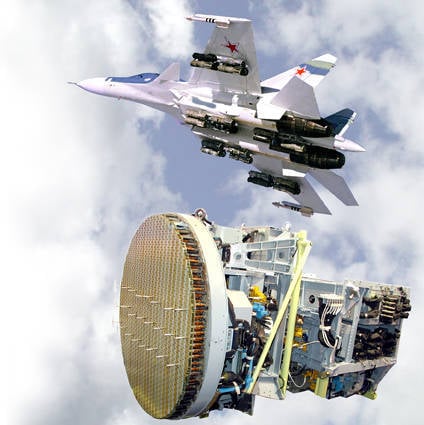Bars radar system
 Today there has been an increased interest in the technical characteristics of the Su-30MKI aircraft, which is in no way inferior to the pride of the US Air Force F-22 aircraft. Obviously, it’s not so much the Su-30MKI itself that is of interest, but the fact that this is the first export fighter equipped with the BARS electronic scanning radar system.
Today there has been an increased interest in the technical characteristics of the Su-30MKI aircraft, which is in no way inferior to the pride of the US Air Force F-22 aircraft. Obviously, it’s not so much the Su-30MKI itself that is of interest, but the fact that this is the first export fighter equipped with the BARS electronic scanning radar system.The “BARS” class radar control system (“BARS” radar control system) is a unique complex that implements the superiority of an antenna with integrated electronic scanning over mechanical scanning antennas and the capabilities of computer systems, including digital processing of the received radar signals. The onboard control system of the BARS radar system together with the onboard systems of the aircraft provides:
- simultaneous firing of missiles at multiple targets in ranged mode;
- issuing information about the tactical situation in the forward hemisphere of a combat aircraft when accompanied by ground and surface targets;
- firing a single target with missiles in the mode of conducting close combat;
- control of the flight of the aircraft when participating in hostilities by land, air and sea;
- the use of air-to-air weapons together with other aircraft of the system;
- information support of all onboard systems of the aircraft;
- integrated processing of data received from other aircraft to significantly improve the efficiency of combat use of the aircraft;
- recognition of the type of air targets in the relationship;
- assessment of the current state of equipment and weapons at all stages of preparation on the ground and in flight.
Main TTX devices
Phased antenna array with integrated hydraulic drive, deflection angles (maximum) when accompanied by a single target, degrees:
- in elevation + 40
- in azimuth + 70
scanning zone during preliminary search and target capture in close combat, degrees:
- on a corner of a place-15 ... + 40; + 7,5
- in azimuth + 3; + 10
scanning zone with simultaneous tracking of targets, square hail. Xnumx
Receiver:
noise ratio, dB 3
number of 3 channels
Transmitter:
power in kW not less than
- illumination (radio correction) 1
- pulse 4-5
- average 1,2
Programmable signal processor:
peak productivity when performing
Butterfly-class operations, pug 75
data entry rate, mhz 28
Radar control processor
size of processor flash-memory, mb 16
number of 3 processors
size of static processor memory, mb 16
Air-to-surface mode
Detection range, not less, km:
- Group tanks 40-50
- railway bridge 80-120
- The destroyer 120-150
resolution, m about 10
Air-to-air mode
Fighter capture distance, not less, km:
- on follow up courses 60
- on a collision course 120-140
The main modes of operation of the radar:
“AIR - SURFACE”
- mapping with Doppler beam detection;
- real ray mapping;
- mapping with the synthesis of aperture;
- measurement of coordinates to the ground target;
- selection of ground moving targets;
- tracking up to two ground targets.
“AIR - AIR”
- search with distance measurement;
- search by speed;
- search and capture in melee;
- precise tracking up to 4's targets to ensure use weapons without stopping the search;
- escort to 15-ti targets on the aisle to assess the tactical situation;
- target illumination and transmission of radio correction commands during missile guidance;
- defining the characteristics of a group goal while maintaining a review.
- recognition of the type of goal by its spectral characteristics;
“AIR - SEA”
- distant maritime search;
- marine search;
- selection of moving sea targets;
- measurement of the coordinates of stationary or moving sea targets.
The “BARS” radar control system is adapted for installation on Su-30MKM, Su-30МКА, Su-30МКИ airplanes. Currently, work is being done to improve the performance of the BARS radar control system.
The implementation of the provided measures will allow to ensure significant superiority over the radar systems both on the existing F-15, F-16, F-18 and other aircraft, as well as their improved modifications in the context of switching to active phased antenna arrays (AFAR).
Radars with AFAR, as a rule, are compared with radars without AFAR, but in reality they indicate the drawbacks of the antennas with mechanical scanning. In the modern BARS radar, a passive phased array antenna or PFAR is used. PFAR is not AFAR, but compared with mechanical scanning antennas it has the same main advantage - the potential of almost minute installation of the antenna beam at a specified point in space. The main admissible advantages of AFAR in comparison with PFAR are the high reliability of the antenna-transmitting path and work in the extended frequency range. This has a positive effect on the noise immunity of the complex, and will allow to solve more tasks in parallel.
The development of the “BARS” radar control system began in the difficult for the state 90-s. Despite this, it was possible to create a strong cooperation in the development and further mass production of the radar system. For the first time in the development of a radar complex, combat systems used computing systems developed and supplied by the Indian side.
Information